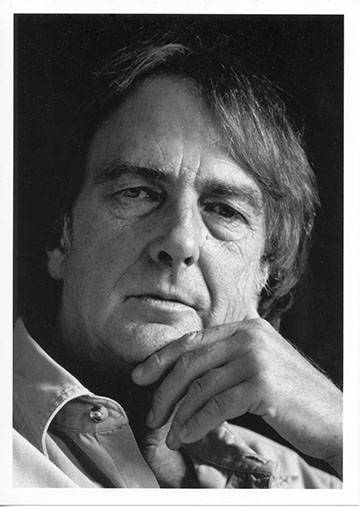


Charles Bowden by Steven M. Johnson, © 1997
Uncompromising investigative reporter dies at age 69 on August 30, 2014
RELEASED September 4, 2014
SAN MARCOS, TX—On the afternoon of Saturday, August 30, 2014, border chronicler Charles "Chuck" Bowden passed away in his sleep at his home in Las Cruces, New Mexico. He was 69.
The Wittliff Collections at Texas State's Alkek Library in San Marcos are proud to hold the correspondence, drafts, research materials, photographs, and other papers of Charles Bowden, an uncompromising investigative reporter, social commentator, and visionary writer who will surely be studied long into future.
Recently processed and now open for research, the Charles Bowden Archive at the Wittliff Collections measures 50 linear feet and spans his life and work into 2007. The materials document his prolific career and cover topics ranging from nature and the environment to the turbulent U.S./Mexico border, particularly the area of Ciudad Juárez. The Bowden collection is arranged into subject series that include Education, Newspaper Writing, Magazine & Freelance Writing, Published Books, Published Essays, Speaking Engagements, Research, Correspondence, Photographs, and more.
Bowden's obituary by Dylan Smith can be read in the Tucson Sentinel, and the page includes several videos of Bowden speaking about his work.
Bowden began his career as an academic with a University of Wisconsin-Madison doctorate in history. Although he published several books, and received a prestigious Guggenheim Fellowship in 1979, it wasn't until he abandoned academia for the newsroom in his mid-30s that he discovered reporting, which changed his life and career.
Bowden was known for both his stream-of-consciousness introspection and thorough research. He was a writer who could seamlessly sew the subjective and objective together. In addition to publishing more than 25 books and hundreds of magazine and newspaper articles, Bowden was a renowned contributing editor for GQ and Mother Jones, and a writer for Harper’s, Esquire, the New York Times Book Review, and Aperture. He won the 1996 Lannan Literary Award, was the United States Artists 2010 Rockefeller Fellow, and received the PEN First Amendment Award in 2011.
Bowden’s areas of interest were tied to his home and the land, and included U.S.-Mexico border issues such as the environment, migration, drugs, and violence. He believed in writing with purpose: for social justice and change as well as ecological awareness and responsibility.
In Down by the River: Drugs, Money, Murder, and Family (2002), the story of an American family torn apart by its ties to both the DEA and the drug industry, readers can see Bowden’s trademark technique of exploring a national phenomenon through the story of an individual—himself in the case of his early memoirs.
Bowden is considered one of the earliest U.S. border reporters, in particular for his award-winning 1996 Harper’s article “While You Were Sleeping,” which broke the story of violent deaths of women in the border town of Juaárez, Mexico, in the U.S./ English-speaking press. The article became the foundation for Juárez: The Laboratory of Our Future (1998), a collaborative Aperture book between Bowden and the street photographers who were then capturing violent crime for the Juárez daily papers.
One piece from his archive is the small spiral notebook showing his idea for the Harper's story: to “capture a photographer taking a photo and through that act take down the city to a place it cannot be denied or misunderstood.” What resulted was the graphic and hard-hitting article published in December 1996, about not just one Juárez street photographer but the 13 who risked their lives chasing the poverty, pollution, and violence ripping through their city.
He is not without his critics. Some conflate Bowden's reporting on the violence in Cuidad Juárez with the sensationalism and fetishism that grew around this topic and garnered the label ‘femicide.’ Others take issue with his use of documentary photos with little explanatory text in Juárez, claiming that the images are falsely portrayed as objective and that they obscure the nuances and complexity of the city. On the other hand, a 2011 article in The Guardian titled "Ciudad Juárez is all our futures" states, "Twelve years ago [Julián] Cardona and the writer Charles Bowden curated a book called Juárez: The Laboratory of Our Future. They could not have known how prescient their title was. In a recent book, Murder City (2010), Bowden puts it another way: 'Juárez is not a breakdown of the social order. Juárez is the new order.’"
Bowden interviewed major drug cartels, DEA agents, and individuals who cross these lines daily. At a Wittliff Collections' discussion last year, writer John Phillip Santos related that, while traveling in Chiapas, he caught sight of Bowden and “quickly got out of there,” well aware of Bowden's tendency to gravitate toward dangerous situations.
As well as covering politics and corruption, Bowden wrote articles about the environment and collaborated with photographer Jack Dykinga on five books of Southwest photography. His stories start and end on the streets, or in some cases in the desert. In the early 1980s, he walked from the border to Tacna, Arizona, for a story on migration. His passion for hiking and camping led to many articles, and he became active in the creation of the Sonoran Desert National Monument. When asked what he considered the Best Tucson Landmark in a 2009 Q&A article published in 2009 by Tucson Weekly, he responded, "Landmarks are an error. The real landmark is the ground beneath your feet. If you don't take care of it, it will kill you."
- Facebook
- Twitter
- Instagram
- Youtube
Email List